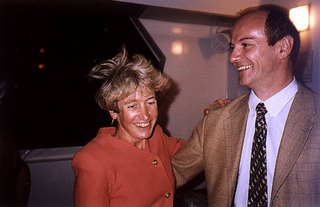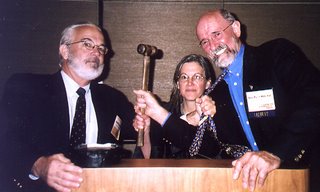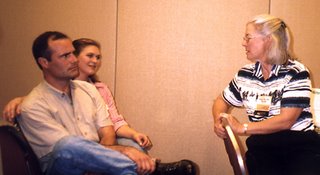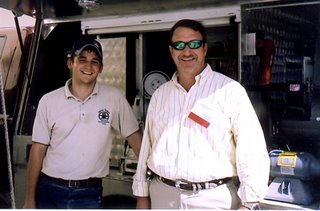The schedule for the 2004 American Association of Equine Practitioners Convention arrived at the office yesterday. The convention will be held December 4-8 in Denver, Colorado, and of course,
Hoofcare & Lameness will be there with a double booth this time in the huge trade show.
Here are a few highlights from the schedule that may interest
Hoofcare & Lameness readers.
Friday 12/3 Foot Surgery wet lab with Kent Carter, Bill Moyer, and Robin Dabareiner--the Texas A&M hoof surgery team--or Advanced Ultrasound with Jean-Marie Denoix, Norm Rantanen, Ron Genovese, and others.
Saturday 12/4 1-3 pm "Veterinarian-Farrier Relations Committee" is listed; I don't know if this is an open meeting or not. Stacey and I will be there setting up the booth that day (helpers welcome!).
Sunday 12/5 10 a.m. Larry Bramlage presents the "Kester News Hour". This is always fun--a rapid-fire review of veterinary developments over the past year, with some humor thrown in.
Sunday 12/5 NOON--Bill Moyer and our farrier friend Bob Pethick will host a lunchtime "table topic" on therapeutic shoeing. Should be great! Also at the same time: Cushings Disease and Hind Limb Lameness.
Monday 12/6--get up before dawn (or just stay up) for sunrise sessions on foot lameness, gaited horse lameness, racehorse lameness, laminitis, western performance horse lameness, and a lot more by presenters such as Bill Moyer, Tracy Turner, Scott Bennett, Scott Morrison, Steve O'Grady, Jay Merriam, Rick Mitchell, Reynolds Cowles, Kent Carter, Terry Swanson, Jerry Black and many more. You must reserve in advance!
Monday 12/6 1:30 I am looking forward to a group of presentations under the heading "The Unwanted Horse"..but unfortunately at the same time are "how-to" sessions with Tracy Turner, Steve O'Grady and Kevin Keegan on saddle fitting, canker, and head/pelvis movement evaluation in lameness diagnosis, respectively. I won't miss those three, but hope to see some of the welfare presentations, too!
Tuesday 12/7 The sports medicine session starts at 8 a.m. with one of our consulting editors, Sue Dyson, presenting "Collateral Desmitis of the Distal Interphalangeal Joint in 62 Horses". This is a great topic on what I think will be a new BUZZ in our industry. (Read Jean-Marie Denoix's article "Collateral Ligaments of the Distal Interphalangeal Joint: Anatomy, Roles, and Lesions" in Hoofcare #70 for more on this subject.)
Tuesday 12/7 At the same time Sue is presenting, there will also be an imaging panel in progress, with Jean-Marie Denoix, Rick Mitchell, Kent Carter, etc.
Tuesday 12/7 Lameness Program begins at 1:30 (unfortunately overlapping with the tearing down of the trade show! Helpers welcome!) with EIGHT interesting lectures including Sue Dyson again, this time of a VERY HOT TOPIC: "Is there an association between distal phalanx angles and deep digital flexor tendon lesions"? My guess is that she will be comparing lateral radiographs showing P-3 angle with MRIs of the same foot showing tendon lesions in the navicular area. This should be worthwhile. Robin Dabareiner (navicular bursa medication results), Scott McClure (shock waver therapy for navicular disease) and lots more in that special section of the convention.
Tuesday 12/7 Yes, at the same time, there are medical presentations on Cushings syndrome and thyriod dysfunction, plus Jim Belknap on using COX-2 inhibitors in developmental stages of laminitis.
Wednesday 12/8 A terrific program on sacroiliac lameness with Sue Dyson as moderator; speakers include Cornell's Kevin Haussler, Dan Marks, Jean-Marie Denoix.
Wednesday 12/8 NOON Table topics on shock wave therapy and a great one on treating sore backs with Dan Marks and Midge Leitch.
Wednesday 12/8 1:30 pm Hooray! The Hoof! Rood & Riddle's Scott Morrison (see article in our current issue on maggot debridement therapy) and our old friend (and the only farrier on the program) Bob Pethick from New Jersey will do an afternoon program on farriery, with live horses. In the surgery program that afternoon, Robin Dabareiner will speak on heel bulb lacerations and the UK's Andy Bathe will speak about medial patellar desmotomy cases.
-----
Those are just some of the highlights. Also, I don't know what the AAEP's policy is about non-veterinarians attending, so if you are not a veterinarian, you may want to register in advance to avoid late fees on top of non-member rates.
-----
Hotels:The Marriott City Center is the HQ hotel, but the Holiday Inn is much closer to the convention center and $50 less per night. Hoofcare rooms will be at the Holiday Inn.
-------
At the trade show: Visit the Hoofcare & Lameness booth and learn about the exciting new "in the field" (literally, sometimes) gait analysis system from the UK "Equinalysis", plus new lameness-related or farriery products from St Croix Forge, Harmany Equine, Eponaire, Grand Meadows, and The Smart Boot.
PLUS socialize at our booth during book signing events with Joyce Harman (The Horse's Pain-Free Back and Saddle Fitting Book), Hilary Clayton (The Dynamic Horse) and Doug Butler (Principles of Horseshoeing III), to name a few.














